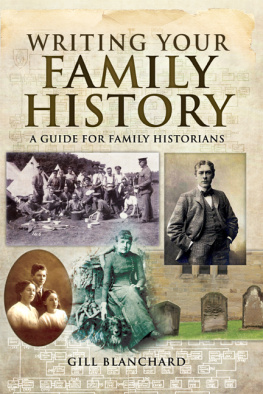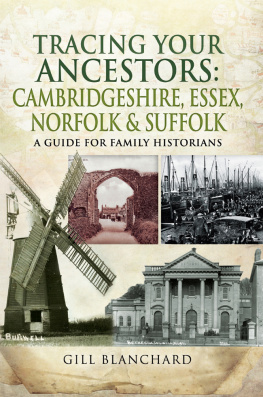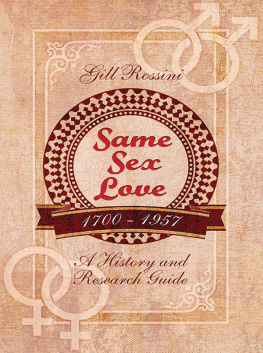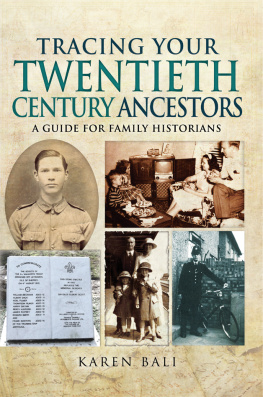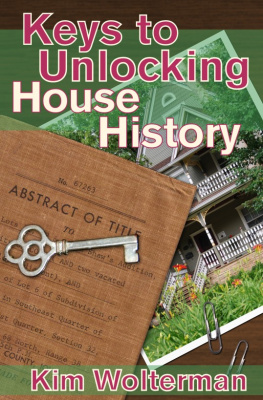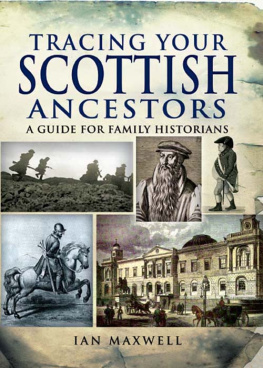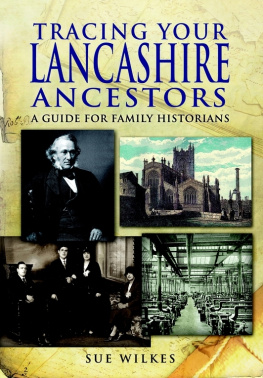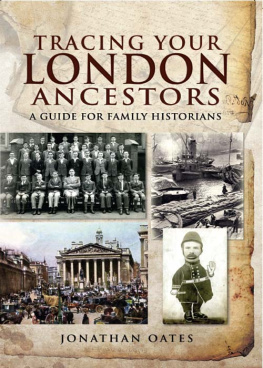FAMILY HISTORY FROM PEN & SWORD
Birth, Marriage and Death Records
David Annal and Audrey Collins
Tracing Your Channel Islands Ancestors
Marie?Louise Backhurst
Tracing Your Yorkshire Ancestors
Rachel Bellerby
Tracing Your East Anglian Ancestors
Gill Blanchard
Tracing Your Royal Marine Ancestors
Richard Brooks and Matthew Little
Tracing Your Pauper Ancestors
Robert Burlison
Tracing Your Huguenot Ancestors
Kathy Chater
Tracing Your Labour Movement Ancestors
Mark Crail
Tracing Your Army Ancestors
Simon Fowler
A Guide to Military History on the Internet
Simon Fowler
Tracing Your Northern Ancestors
Keith Gregson
Tracing Your Ancestors Through Death Records
Celia Heritage
Your Irish Ancestors
Ian Maxwell
Tracing Your Scottish Ancestors
Ian Maxwell
Tracing Your London Ancestors
Jonathan Oates
Tracing Your Tank Ancestors
Janice Tait and David Fletcher
Tracing Your Air Force Ancestors
Phil Tomaselli
Tracing Your Secret Service Ancestors
Phil Tomaselli
Tracing Your Criminal Ancestors
Stephen Wade
Tracing Your Police Ancestors
Stephen Wade
Tracing Your Jewish Ancestors
Rosemary Wenzerul
Fishing and Fishermen
Martin Wilcox
Tracing Your Canal Ancestors
Sue Wilkes
Tracing Your Lancashire Ancestors
Sue Wilkes
First published in Great Britain in 2013 by
P E N & S W O R D F A M I L Y H I S T O R Y
an imprint of
Pen & Sword Books Ltd
47 Church Street
Barnsley
South Yorkshire
S70 2AS
Copyright Gill Blanchard 2013
ISBN 978 1 84884 254 0
PDF ISBN: 9781783376537
EPUB ISBN: 9781783376445
PRC ISBN: 9781783376544
The right of Gill Blanchard to be identified as the Author of this Work has been
asserted by her in accordance with the Copyright,
Designs and Patents Act 1988.
A CIP catalogue record for this book is
available from the British Library.
All rights reserved. No part of this book may be reproduced or transmitted in any form
or by any means, electronic or mechanical including photocopying, recording or by
any information storage and retrieval system, without permission from the Publisher
in writing.
Typeset in Palatino and Optima by
Phoenix Typesetting, Auldgirth, Dumfriesshire
Printed and bound in England by
CPI Group (UK) Ltd, Croydon, CR0 4YY
Pen & Sword Books Ltd incorporates the imprints of
Pen & Sword Aviation, Pen & Sword Family History, Pen & Sword Maritime,
Pen & Sword Military, Pen & Sword Discovery, Wharncliffe Local History,
Wharncliffe True Crime, Wharncliffe Transport, Pen & Sword Select, Pen &
Sword Military Classics, Leo Cooper, The Praetorian Press, Remember When,
Seaforth Publishing and Frontline Publishing
For a complete list of Pen & Sword titles please contact
PEN & SWORD BOOKS LIMITED
47 Church Street, Barnsley, South Yorkshire, S70 2AS, England
E-mail:
Website: www.pen-and-sword.co.uk
CONTENTS
Photographs, Postcards, Paintings and Drawings
PREFACE
T he place we call home is more than just a structure. Its style and design reflect the personality and personal interests of the owners, designers and builders. It is also affected by fashion, architectural and artistic influences, the geology of area it was built in, and even politics and religion.
This book will help you to trace the history of your home, the people who lived in it and its local and social history whatever its age, size and origins. The term house is used throughout as a generic term for any type of building that people live in, although the sources and resources explored can be used for researching other types of building or places associated with your ancestors.
This guide focuses on English and Welsh research as there are some major differences in resources available for Ireland and Scotland and, in the case of Scotland, how land was held. Northern Ireland is included because it does have some records in common with England and Wales.
Whilst no guide should ignore national resources the vast majority of your research will be conducted at your local library or record office. This guide explores those local resources in depth as well as directing the researcher to what can be found at The National Archives and online. It also makes the research process understandable, and in the process demystifies some of the language and documents you will come across.
As a result this is a holistic guide on how to gather evidence from buildings; understand the important of architectural changes and influences of local craftspeople; explore the local area in order to place modern buildings in their historical landscape and find and use documentary sources. Discovering who lived in your property and how and why a building has changed use over time are also absolutely crucial to investigating its history.
Each section within this book has a finding section, which lists useful addresses, websites and recommended publications. The introductory section provides details of where to go and complementary websites.
A major step is to physically date your building and place it within a time period. This is why a chapter on dating your home, which looks at architecture and how houses have developed over time, comes first. Within this are some tips on what to look for when reading a building and other resources for developing this skill.
Another major section is Building up Knowledge of Your Local Area. I have deliberately not called this just local history, as tracing the history of a house is more than just looking at how it has evolved physically over time. Whether new or old, it is all about the place a building stands in, and the people who built it, made changes and shaped its personality. This is an organic process which helps create a buildings character or feel. This chapter encourages you to put your home in its local context and in doing so you may uncover relevant information and expand your research in all sorts of directions.
Researching the history of your house will take you on a journey through a huge range of documents and other resources locally, nationally and online. Whilst some types of records are complex and difficult to understand or read, even the most seemingly straightforward can throw up problems and questions. The documents and resources section introduces you to each of the main types of records you may use. It starts with a brief overview of the variety of records that can be used to discover your homes history and then looks at each resource in more depth alphabetically. There is also a timeline of key historical events and the creation of documents relevant to researching the history of your home.
Before beginning your research it is vitally important to identify your house on a modern map and take it with you when visiting archives, as the landscape is likely to have changed over time. Note on the map where it is in relation to prominent landmarks such as a church or pub that has stood there for some time. When comparing it with old maps look at how roads may have changed shape, size and direction, and whether the street on which it was built corresponds with old field boundaries.
People are what make a house a home, and it is by tracing the men, women and children who lived in them that we find out the most. Investigating the history of your house therefore involves a certain amount of genealogical and local history research. For instance, census returns will give you details of who these people were, when and where they were born, and their occupations. This in turn may lead you to other resources such as wills, which may give you more detail about the property and bring the people who once lived or worked in it to life.
Next page

